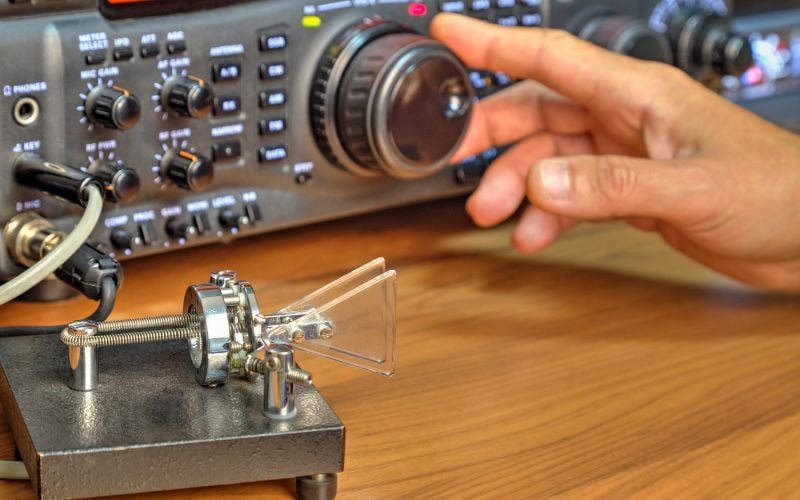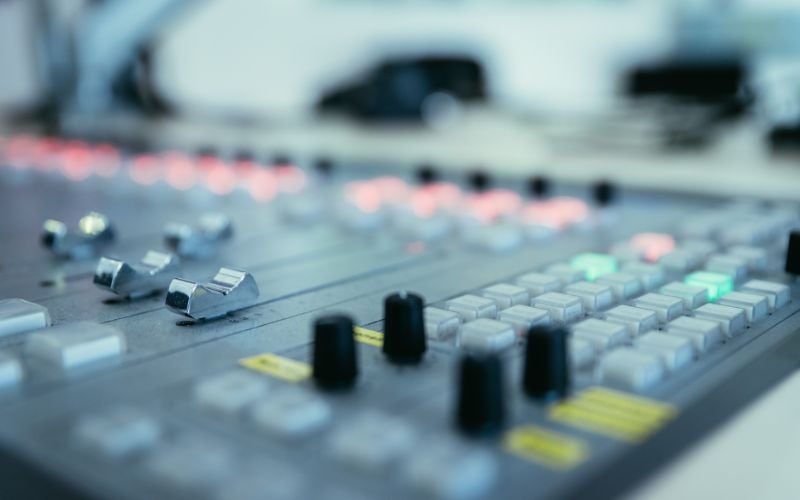Clear Channel Radio or Clear Channel Communications is one of the most famous radio powerhouses in the history of broadcasting.
Today the company is better known as iHeartMedia Inc – the most prominent radio parent company in the United States.
In fact, iHeartMedia is responsible for more than 850 stations. That’s many times the number of channels owned by any other major media conglomerate.
The current brand iHeartMedia specializes in radio broadcasting, live and digital events and podcasting. It is well known not only in USA but in regions worldwide.
But where did the Clear Channel Radio story begin? How did Clear Channel Communications become such a significant player in the audio industry?
Here’s everything you need to know about the history and development of the incredible Clear Channel Radio brand.
The Beginning of Clear Channel Communication: Early Days

Lowry Mays, one of the founders of Clear Channel Communications (iHeartMedia), changed history forever by saying yes to a simple request.
In his early years, Mays pursued a career in investment banking, building on his Harvard University degree.
Then one day, two men came into his office asking for his help to raise $175,000 to buy a ailing FM transmitter.
Mays agreed to help buy the station known as KEEZ and began researching the radio landscape to study the potential profitability of the landscape.
As he prepared to help with the radio project, the two men who originally proposed the purchase decided to step out of the deal.
However, Mays was already emotionally invested in owning a radio station. So he decided to take the opportunity independently and enlist the help of BJ (Red) McCombs.
After borrowing $175,000 from a bank, he bought KEEZ as an investment with no intention of going into the broadcasting business.
Within a year, Mays helped transform KEEZ into a highly profitable company. At this point he was hooked.
With the cash flow generated by his new station, Mays and McCombs decided to buy some additional stations. The brand bought a clear channel AM transmitter, WOAI, in 1975.
A year later, in 1976, they branched out outside of San Antonio and bought KMOD-FM and KAKC in Tulsa. All transmitters were taken over under the name San Antonio Broadcasting.
In the years that followed, Mays invested more heavily in the radio industry. He focused primarily on buying distressed stations in mid-sized markets like New Orleans, Louisville, and Memphis.
Each station underwent a rigorous vetting process before joining the Clear Channel group.
The 1980s and the Clear Channel public offering


In 1984 developments in the broadcasting landscape began to unfold and offered new growth opportunities.
The Federal Communications Commission has begun reducing restrictions on television and radio station ownership. Clear Channels Communications was given the green light to purchase new channels and went into action.
Mays prepared for a new era of rapid expansion by popularizing the Clear Channel Communications company.
The company earned $7.5 million in funding and began acquiring broadcast real estate to take advantage of relaxed ownership restrictions.
However, due to the company’s strict purchasing process, the purchase process was initially slower than expected.
By 1987, radio acquisitions had ground to a halt, and Clear Channel began looking at television instead.
They bought a station in Mobile, Alabama — a subsidiary of the Fox TV network — and Mays also bought numerous other Fox affiliates.
The decision to dive into the television landscape proved to be an excellent opportunity for Clear Channel Communications. The television network Fox developed into one of the largest television networks in America.
Meanwhile, Mays’ radio acquisitions thrived. By 1991, the company’s six television stations and 18 radio stations generated revenues in excess of $1 million.
The 1990s and further expansion


In 1992 Mays shifted his focus back to the radio industry, motivated by changing conditions in the landscape.
In the 1980s, an economic recession hit the landscape, making it difficult for many companies with radio stations to continue managing debt.
As a result, station prices fell dramatically, and Mays began to capitalize on it.
By 1993, Clear Channel Communications had purchased 31 radio stations and seven television stations for a total cost of $110 million.
In 1994, Clear Channel merged with one of its competitors, Metroplex Communication. It began buying stations outside the United States, acquiring a 50 percent stake in the Australian Radio Network.
Thanks to May’s careful planning, Clear Channel was in a fantastic position to buy more companies until the FCC relaxed rulings.
Additionally, a new Telecoms Act was enacted in 1996, allowing companies to own even more broadcasting brands.
By June of that year, Clear Channel had acquired television and radio stations worth $581 million.
The company grew quickly, benefiting from rising share prices and an excellent reputation in the industry.
At the end of 1996, Clear Channel owned 11 television stations and 121 radio stations. It became the second largest radio group in the US.
Meanwhile, Capstar Broadcasting was founded in 1996 and quickly became the largest radio station owner in the country.
With 243 stations already, the company announced plans to purchase SFX broadcasting in 1997.
A year later, Capstar and Chancellor Media Corporation merged into one company with 463 stations.
Finally, in 1999, Clear Channel acquired the merged company, which later became AMFC Inc. The result left Clear Channel Communications with 19 television stations and 830 radio stations across the United States.
Development in the 2000s: takeovers and bankruptcies



In 2006, Clear Channel announced a plan to go private after being bought out by two private equity firms for approximately $26.7 billion.
At the same time, Clear Channel began selling its television stations and over 500 smaller radio stations because private equity buyers were uninterested in those properties.
However, due to the credit market crisis in 2007, Clear Channel had difficulty selling some of its channels and the buyout completion date was extended.
At the beginning of 2010, the company was threatened with bankruptcy due to significant debts. Mays eventually resigned as CEO and President of Clear Channel in June of that year.
In 2013, Clear Channel divested its minority stake in rival company Sirius XM, and many Clear Channel stations were subsequently removed from the other brand’s service.
In 2014, Clear Channel Communications decided to update its branding.
The company felt its name needed a makeover due to its innovative approach to the broadcast market. Clear Channel radio was still associated with the AM radio landscape.
Clear Channel Radio is used for an AM channel on which only a single station is broadcasting.
By then, Clear Channel Communications had already made significant inroads into the digital and FM landscape. The new name iHeartMedia was chosen for its broader appeal.
The iHeartMedia brand continued to evolve. However, it was still struggling with significant debt. Many of the company’s media outlets claimed that an impending bankruptcy was likely.
In 2017, publications reported that creditors had rejected iHeartMedia’s debt restructuring proposal. In 2018, the company filed for Chapter 11 bankruptcy.
The resurgence of iHeartMedia
Despite a multitude of challenges, iHeartMedia emerged from bankruptcy and resumed strategic acquisitions.
Podcast HowStuffWorks was purchased in 2018, and the company also announced its intention to buy Jelli, a programmatic advertising platform.
In 2019, the US Bankruptcy Court approved a plan designed to help iHeartMedia end bankruptcy once and for all. The plan also included a spin-off strategy for iHeartMedia’s advertising business, Clear Channel Outdoor.
That same year, the media brand proposed an IPO to build new revenue for years to come.
Rather than proceeding with the IPO, iHeartMedia was approved for a direct listing on the Nasdaq and began seeking investors.
In 2020, the brand announced significant restructuring efforts to modernize the business and capitalize on new growth opportunities.
This included restructuring the market groups into three different divisions for different markets.
In addition, a unit for multi-market partnerships has been added.
The reorganization was accompanied by a significant round of layoffs and transfers affecting various on-air personalities and employees.
Since then, iHeartMedia has grown again and found new ways to connect with its audiences through the various mediums it invests in.
Despite significant turmoil, the company remains the largest owner of radio stations in the United States landscape today.
The Fall and Rise of Clear Channel Communication
Like many large companies, Clear Channel Communications has had its fair share of ups and downs over the years.
After a hugely successful start in the radio landscape, the company quickly expanded into new forms of media and accelerated its growth.
However, it was not immune to the problems caused by economic downturns and subsequent debt.
After filing for bankruptcy and laying off some employees, iHeartMedia has remained relatively strong.
The company continues to function as the leading umbrella brand for radio stations in the United States. The brand also invests in advertising and television networks across multiple channels.

